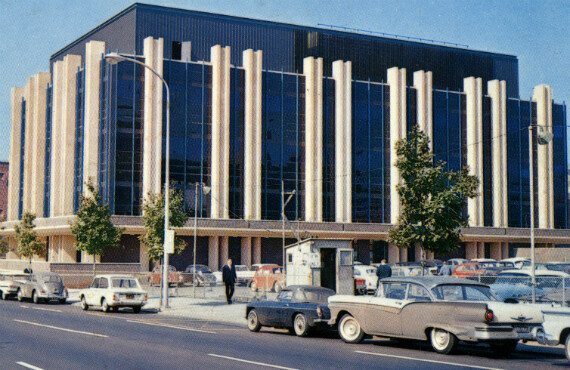Penn Student Chronicles the Emergence of Interdisciplinary Science Through Architecture
By Madeleine Stone @themadstone
Collaboration across scientific disciplines can lead to groundbreaking innovation. But, just as it takes a special type of scholar to cross academic boundaries, it takes a special type of building to make interdisciplinary alliances possible.
Few pause to consider the question of how physical spaces can influence academic culture. Brit Shields a graduate student in the University of Pennsylvania’s History and Sociology of Science Department,is one who does.
In a paper recently published in the journal Minerva, Shields and co-author Hyungsub Choi, an assistant professor at Seoul National University, chronicle the history of the Laboratory for Research on the Structure of Matter, a building that, for five decades, has helped to shape and grow the field of materials science at Penn. More broadly, buildings like the LRSM, and now the Krishna P. Singh Center for Nanotechnology, serve as physical manifestations of Penn’s saga to establish interdisciplinary culture.
Shields, whose thesis focuses on the intersection of architecture and scientific practices, was first introduced to the LRSM when she began studying the history of the field of materials science with Penn emeritus professor Ruth Schwartz Cowan. Cowan introduced Shields to Choi, an expert on the topic who was, at the time, working at the Chemical Heritage Foundation in Philadelphia.
“At our first meeting together, we found that our research interests really complemented one another,” Shields says. “We thought that we could share a compelling history of materials science and nanotechnology within the context of architecture.”
That first meeting launched a fruitful collaboration between the two science historians, culminating in their recent publication chronicling the LRSM in the context of interdisciplinary culture.
The story of the LRSM begins in the late 1950s, when physicists, chemists and engineers became interested in developing a deeper understanding of the structure and properties of matter. With the acceleration of the Cold War arms race following the Soviet Union’s launch of Sputnik in October 1957, the United States government recognized the need to develop the nascent field of materials science.
At the time, interdisciplinary research was a new term and most academic scientists were segregated according to traditional departmental boundaries. Penn, along with Cornell and Northwestern universities, was among the first higher education institutions awarded a federal grant to establish an interdisciplinary laboratory for research and training in materials science. That grant, along with additional University funds that Penn professor of metallurgy John Hobstetter helped to procure, would be used to establish the LRSM.
What followed was one of the very first discussions not only about the place of interdisciplinary research at Penn but how to create a space that could break down disciplinary boundaries. The University hired a local architecture firm, led by Penn’s School of Architecture alumnus Sydney Martin, to design the building. Martin recognized the natural tendency of researchers to associate with others of their discipline as an architectural design challenge.
“From the beginning, architecture was seen as part of the solution,” says Shields.
“There was a conscious effort to use space creatively to foster interaction among researchers from different disciplines.”
The resultant building was like nothing the University had ever seen. Each of the LRSM’s four floors was laid out like a racetrack, with a shared laboratory facility at the physical center. These core facilities housed state-of-the-art equipment to be used by researchers of all disciplines. Personnel making chief use of each facility had offices and individual research labs located around the circumference.
As a result, offices were not assigned with regards to traditional departments but based on shared instrumentation needs.
“The idea was that researchers across disciplines who made use of the same equipment would consult and interact with each other and mutually benefit from each other’s knowledge,” says Shields.
At the time, this was very novel.
During the LRSM’s development, concerns were raised over the loss of traditional departmental identities. But it wasn’t long after the building opened its doors in 1965 that faculty and department heads came to appreciate the advantages of the new arrangement.
“There was discussion beforehand about the anxieties of departing from traditional departmental organization. People were concerned that the departments would be threatened,” Shields explains. “But, over time, as the number of faculty and students in materials science grew, that concern was replaced with excitement.”
The LRSM, which recently marked its 50th anniversary, may have begun as an experiment, but over the years Penn has come to embrace many forms of interdisciplinary collaboration. Still today, physical spaces tell the story of emerging fields.
In their paper, Shields and Choi point to the Singh Center for Nanotechnology, which opened in 2013, to support Penn’s growing nanotechnology research community, as a modern day counterpart to the LRSM.
Like the LRSM, the Singh Center was carefully designed to maximize the potential for collaboration between its residents: researchers with diverse backgrounds in biology, chemistry, physics and engineering. For example, when architects were planning the building, they were faced with a peculiar problem. Elevators could not be placed anywhere save the building’s far ends. Otherwise, they might interfere with the electromagnetic fields of several highly sensitive instruments.
“So, they built a really majestic staircase through the center of the building and landings with small lounges on every floor,” says Shields. “You can bump into someone on the stairs and stop to sit and have a conversation. This creates ample opportunity for informal meet-ups and knowledge exchange.”
As Shields continues to explore the intersection of architecture and scientific culture, new questions have emerged, including how to define success in an interdisciplinary program and how buildings can be designed to accommodate the ever-changing technological requirements of an evolving field.
“Doing this research project has really helped me build a methodology and refine my interests,” Shields says.
And Penn, committed now more than ever to fostering interdisciplinary science, will continue to be a ripe ground for discovery for years to come.








